The cult of the dead men is so ancient as the man.
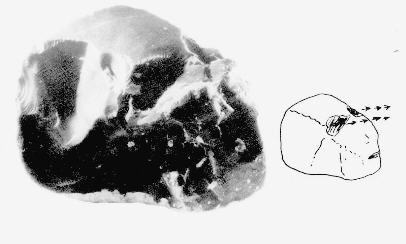
So-called "fertile crescent" was extremely propitious place to the stable installations, also for the abundant presence of a spontaneous wild cereal, the einkorn, that later on to accidental hybridizations with other wild graminaceous of the area was at the origin of new varieties that made the zone more and more rich and suitable for to the sedentary lifestyle.
In virtue of such favorable conditions, such territory became the crib of the civilizations in how much the natural wealth of the place allowed inventions and progress.
In particular, to the end of the IX and during the VIII millennium B.C. (Pre-Pottery Neolithic B, PPNB), above all in the arts, was a great blooming, supported by the manifestation of a rich symbolic function.
According to the current archaeological searches, it was at first the feminine image, symbol for excellence of life and fecundity, to express the religious feeling of the man, like attested from the plentiful blooming of statuine in stone before, and then in terracotta, the so-called Venuses, see . THE NAKED WOMAN (VENUS) IN PALEOLITHIC SCULPTURE, representing the knot body of the woman, emphasized in her characteristics of genitrix, present near all the cultures in the several parts of the world.
The current typology of the Art is present in the Paleolithic (lower, middle and upper), in the Neolithic of the Mediterranean basin and in the I millennium B.C. in Mexico, associated with the types of THE BICEPHALIC HUMAN HEAD IN THE PALEOLITHIC SCULPTURE , in how much some Venuses have the head with two faces or have two heads (see A NAKED WOMAN (VENUS) WITH BICEPHALIC HEAD IN PALEOLITHIC SCULPTURE .
With the first urban civilizations in Middle East, the Venus becomes "goddess of the fecundity", and then"goddess mother".
But the goddess mother includes in self also the death, the other crux aspect of the human eternal vicissitude: the earth-mother gives life and feeds, but also, to the term of the earthly vicissitude, receives the own creature in her merciful womb. Such basic duplicity is testified beginning from the numerous sculptures with double head of the Paleolithic, until the Mesoamerican with half defunct and half of living face, sculptures present also in the ethnography in many tribal masks, and from sculptures in stone like that one of Teotihuacan, representing life and death together.
The death therefore, covering herself of transcendence, she also becomes object of particular cults with religious background: as on the earth the vegetation and every living shape are born and die, in order then newly to come back to life and to perish in an eternal cycle, so perhaps the cult rituals, just for their ritual-cyclical character, presumably are supposed to promote the rebirth from the womb of the earth, consoling the man of shortness of his terrestrial vicissitude.
The knowledge of the death is interlaced to the same life, and is innate to the human being: moreover, recent studies of animal ethology show that the sense of the death is not prerogative of the only man. Observations on the bonobos, chimpanzees that live in the forest of the Ivory Coast, in Africa, as an example attest the sense of pain and the cure for the body of dead companions (Christophe Boesch and Hedwige Boesch-Ammerman, 1989).
Numerous evidences therefore on this knowledge by the man, even if we do not have traces about the most ancient burials, for the too much time passed, the conditions of the interment, and for the natural phenomena also grand that are are hollowed in the time, often twisting the land configuration.
With regard to the cure of the body after the death, both history and ethnography have handed on us several traditions, tied to ideologies and customs of religious order. It is matter of cults from always near all the cultures, directed derived from the believe in a creator God, whose the most ancient known representation is just the Goddess mother, whose vestigia are found nearly everywhere, beginning from the most ancient times.
The fact that, relatively to the remoter times, between the human rests, we have found jaw pieces, where is no presence of others parts of the skeleton, could make to assume a beginning cult of the skull, religiously conserved. In fact, it is not thinkable that it is a case that has been conserved only this part of the body, beyond all more fragile than others of the skeleton, consisting and therefore less easy perishable. Evidently it is matter of a intentional conservative choice.
An other hypothesis on the conservation of the single skull could be tied to the phenomenon of the migrations. In order not to abandon their defunct ones, in his migrations the man carried with himself the symbolically more meaningful part of him, that is the skull, use confirmed also from ethnographic studies. In condition of sedentary lifestyle instead, the burial happened in cave or under the ground of the rooms or in grave to the open, as the dolmen; much similarly later, in historical age, the interment of the illustrious dead men is diffused in the places of cult, or in proximity of them.
Beginning from the most ancient found concrete traces, in any case, the transcendent meant of the burial is inferred next primarily from the cure with which the human rests were buried, and also from the rich equipment of objects near them, especially when they were women, many of which with clear symbolic character, like particular foods, parts of animals, amulets, small sculptures in bone, shells, beyond to the frequent red ocher presence, perhaps symbol of the blood, life and death, and to the particular position and orientation of the posture.
Such complex ritual would not have sense if the burial had been motivated, like supposed by some, from the worry not to leave the bodies in power of carnivorous animals.
The death probably, for the sense of transcendence inborn in the human being, must have been fancied like a long sleep, a rest preceding to an awakening, like still it is said in many prayers for the defunct ones. For it, bodies has been often buried turned towards East.
The archaeological diggings have revealed to us that, in many graves, more individuals were together buried, sometimes in couple, sometimes three, sometimes more, which testifies a desire to rest beside the persons to more loved, and also this would attest the transcendent meant attributed to the ritual of the burial.
Beyond to that, it is the same art to supply evidences that, in parallel with the cult of the life, i.e of the fecundity, the religious feeling universally crystallized around the cult of the defunct ones.
At Sima de los Hueso, Atapuerca, Spain, in a gallery of the cave in which paintings and engravings attest the use of this part of the cave like sanctuary, were recovered 32 rests of Homo heidelbergensis of 200000 years ago.
At Krapina Cave in Croatia have been found in a cave numerous human remains of 100000 years ago, whose fragmentation could also have been caused from the weight of overhanging sediments. With regard to the enfleshing traces, it is possible to assume both cannibals and religious rituals, than customs of cure and conservation of the rests, through preventive and accurate enfleshing of the corpse, still existing rituals near some populations.
In Madagascar, as an example, near a culture of the south-west of the island, survives a particular ritual of burial: the daughters of the defunct, sitting near the river, fleshless his corpse until to the bone, cleaning up then the skeleton because it will be candid like the snow; therefore the bones were separated, placed in a small coffin, and buried with particular ceremonies. Others bury corpses under great heaps of stones, with statuettes representing scenes of the life of the dead person.
All this has character of sacrality, not of perversion, as some could suppose (Cfr. F. Morgenthaler, Forme di rapporto della perversione e perversione delle forme di rapporto, Psicoterapia e Scienze Umane, 2, 1979, p.9 )
An historical data: beginning from the 1300's, a custom prescribed that bodies of illustrious men came divided in pieces, for being transported in far places of interment and sometimes diversified, often after accurate fleshing.
Going back to 100/125000 years ago, in the cave of Moula Guercy , South-East France, have been found the rests of 6 individuals, they also bringing signs of fleshing: also in this case, by some it has been made a hypothesis of cannibalism, but it could also be thought to a fleshing, in order to more accurately conserve the rests of the dead man, supplying good evidences that also this finding can be numbered between the proofs of a conservative cult of the defunct.
At Taramsa, in South Egypt, Nile Valley, a small child of 8/10 years, of 80000 years ago, has been found buried sitting, his face turned towards the sky, east direction.
In Teshik Tash cave, in Uzbekistan, near the Afghan frontier, in 1938 have been found the rests of a child 9 years old, of approximately 70000 years ago, buried with the feet towards the entrance of the cave; around to the skull,
6 braces of horns of Siberian ibex; moreover, a small fire had been ignited beside the body, signs of rituality and affection towards the young dead.
At the Ferrassie (Les Eyzies, Dordogne, France),
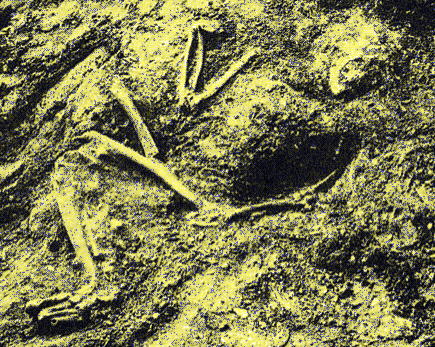
human rests of 70 years ago have been found buried, between which a man in extended position, a woman in bent position, two children, and two fetuses, all with East-West orientation.
Always in France, at the Chapelle-aux-Saints, going back to 60000 years ago, the skeleton of a middle age man has been found, with the head turned towards the west and the feet towards east, an arm raised towards the mouth, the head topped with bones of animals, and close to him the boneses of the leg of a bison.
At the borders with Turkey, North Iraq, in the Shanidar cave, in 1960 Prof. Ralph Solecki unexpectedly founded the skeleton of a man of 60000 years ago, buried in a bed of flowers.
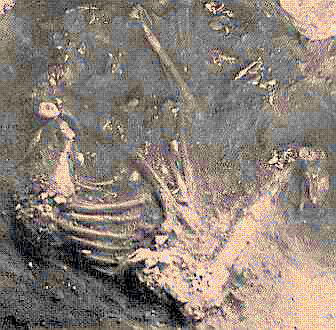
In the Skhul cave, Israel, Mount Carmel, rests of buried individuals of 100000 years ago, with evidences of cult rituals associated. Always going back to 100.000 years ago, in the cave of Jebel Qafzeh (Nazareth) , a woman approximately 20 years old and a child of 6 to her feet. In the Tabun cave, dug by A.J. Jelinek, the grave of a deceased woman of 120000 years ago. The production of tools of this civilization consisted in microlithics of silex, of varied shape, for a large amount of uses. The funeral custom consisted in burying the defunct ones in front of the cave, in position of sleep, with equipment of objects in stone, bone or shell, more or less rich according to the social state of their family . At Kebara cave, buried to the center of a cave, the rests of a man 30 years old, going back to 60000 years ago, was equipped with levalloisian tools.
At Mungo Lake, Australia, an adult of 40000 years ago, with the hands interlaced, placed to the height of the pubis, was buried in a sand dune. The body was overspread of red ocher. It is remarkable the fact that red ocher did not exist in the place, and this testifies how much cure was in the interment of the defunct ones.
In Mezmaiskaya cave, on the mountains of the northern Caucasus, near the Black Sea, buried in the limestone cliff, have been found perfectly conserved the rests of a child of approximately 29000 years ago.
At Sungir, 150 Km East from Moscow, Russian Republic, buried in two graves, two boys (28000 years ago), 8 and 13 years old, in position head to head, and a man, probably with the head covered with a pointed hood, numerous bracelets, and to the neck a small hanging in ivory shaped as horse and of red ocher colored, and decorated from black little dots; the boy had the neck adorned of a pendant having animal shape and other objects in ivory decorated; also the girl, beside him, had several ivory decorations; the three bodies were covered from a thick layer of tusks of mammoth.
The so-called Red Lady (in reality, a man) found in 1826 in the cave of Paviland (peninsula of Gower, Wales, Great Britain), lived 26000 years ago; he takes his name from the burial in red clay and the covering of red ocher; the body was adorned with necklaces of shells and ornaments in ivory.
Same period, at Dolni Vestonice, Czech Republic, the rests of three young people, two boys and one girl, of approximately 20 years. The skulls of the young people were encircled with necklaces of teeth of Arctic seals and foxes, and had been covered of red ocher, which also covered the zone in which the hands of the two men touched the body of the woman.
But, beside the conservation of the entire body, it exists, as it has been said, a particular cult referred to the conservation of the single skull, see . Figs. 3,23 and 3,24
Already in the protoneolithic period there are evidences of a separate conservation of the skull. During the preceramic Neolithic, such use becomes common near some localities of the Near East, Anatolia, Syria, Palestine, Iran and Israel of today.
It assumed a particular importance in the natufian civilization (10500-8500 B.C., so called from the locality-type, the cavern of Shukbah, Wadi en-Natuf).
Near such civilization a cult of the fertilizing forces of the nature was diffused, in parallelism to those human, inspired to a religious relationship between the fertility of the earth and that human.
At Tell al-Sultan (Jericho, approximately 8500 B.C., Neolithic period A pre-ceramic), after the original natufian settlement, and the alternate vicissitudes until the abandonment of the city around 7300 (probably consequently to a change of the climatic conditions), was flourished again a new civilization with houses not more with circular plan, but rectangular, and an intensive use of the chalk, local material, that covered walls and pavements of the rooms, like at Jarmo and Ain Ghazal.
Just in this period (8700-6500 B.C.approximately), called Pre-pottery Neolithic B (PPNB), particular and important of Jericho, and other settlements of the zone, Ain Ghazal, Tell Ramad, Beisamoun, Nahal Hemar, blooms a cult of the skull, more sophisticated and artistic, in comparison with them of the previous times.
Previously, in fact, there was a use for which the skulls came rejoined with the rest of the body, in the grave, or collected in groups of three, or more, in circle, and buried in cavity in the domestic walls, or under the pavement, the look turned towards a same direction.

Parallelly, in some of these localities were produced masks in limestone in natural largeness, and human little figures and animals in chalk, some of which with heads that remember very closely the re-moulded and painted skulls , found buried in holes in front of the houses.
In particular, at Jericho, while the bodies lacking in head continued to being buried in the pavements covered in chalk of the houses, they have been found, accurately put away in hiding places, a ten of skulls artistically moulded in chalk colored, or covered of bitumen, sometimes enriched with painted details (like the moustaches), or with shells in place of the eyes, with the aim to faithfully reproduce the features of the defunct one.
Ulterior diggings have carried to the light, between the others, three statues in chalk in natural largeness: a God-father with the beard, a Goddess-mother and a God-child, according to some interpretations one of the most ancient testimonies of a cult of a fecundatrix Trinity, posterior to the original cult of the God Bell. The three statues, they also ritually buried, have to be reconnected to the cult of the defunct ones.
These remoulded and decorated skulls can be considered true works of art, and have a very precise stylization.
At first, being for the majority of the cases smaller of the original human head, both for the lack of the lower jaw, and for the fleshing, the several parts of the face are placed not exactly like in the truth, but in such way maintaining however the harmonious dimensions of a human face.
When the eyes are closed, they are represented, like the mouth, through an horizontal thin line, with a light rounded protrusion; inside, a light pink coloration is visible. The eyebrows are marked, and traced with a line; the cheeks are sweetly rounded off; the ears, small and light lengthened, are placed in lightly upper position regarding the truth.
At Çatalhöyük, Anatolia, Turkey,
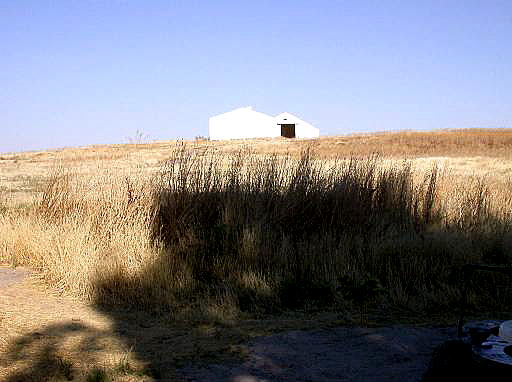
Eight similar skulls, one entire and the others probably fragmented, going back to an age between 7000 and 6500 B.C., have been found also at Ain Ghazal (Jordan) under the pavement of rooms or buried in the proximity.

Removed the lower jaw, the skulls were covered with chalk and modeled in the lacking parts. The style of the modelling remembers the extraordinary statuary of the place, above all in the forehead and in the mouth, nevertheless with a diversity given from the presence in the skulls of the upper dental arcade below. The funeral custom of the place previewed the interment of the corpse: once decomposed the meat, the rests, exhumed, came again buried, generally under the pavement of the house, or in a courtyard, while the skull was dealt with a covering in chalk, after to have been privated of the lower jaw, and sometimes it was buried newly with to the rest of the skeleton (for a more detailed description, see Patricia S. Griffin, Carol To Grissom and Gary Or Rollefson .
At Abu Hureira, Northern Syria, 120 km from Aleppo, on the Euphrates, inhabited between 10,000 and 7000 years ago, and with identical use to cover of chalk pavement and walls of the rooms, have been found the skeletons of 162 individuals.
Also at Tell Ramad, 20 Km south-west of Damascus, at the foot of Hermon Mount, always with equal use of the chalk for the decoration of the rooms, have been found skulls less adulterated and more lengthened, being present the mandibular part, simply decorated with red ocher. Associated, have been found two figures of persons sitting, in chalk, perhaps to guard of the buried skulls.
At Nahal Hemar, south-west of the Dead Sea (Israel), in a cave probably used for rituals of sacred cult, have been found, jointly with masks in stone decorated with marine shells, baskets, woven, points of arrow in wood, tools in silex, also three skulls decorated with a kind of engobbio constituted from crossings of black substance collagene, impermeable glue of animal animal, similar to that one used 4000 years after by the Aegyptians: also the mouth appears modeled with the same substance.
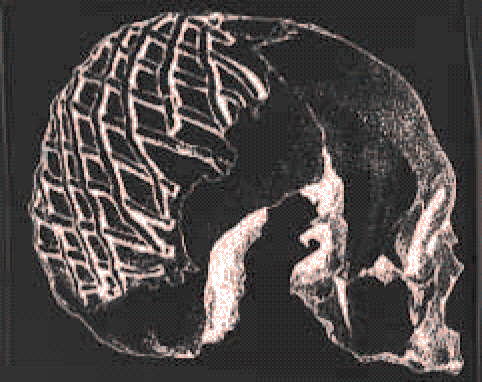
A hypothesis could be that such treatment has been devised for being able to practice religious rituals at the open, like in use near nomadic populations.
At Beisamoun (Israel of today), more or little going back to the same age, has been found a skull dealt like those of Ain Ghazal, but the eyebrows, recorded rather than painted, and the painted eyes closed.
In a calcolithic cave near Peki'in (Israel) much funeral material datable from 4500 to 3,500 B.C has been found again. Like supposed by the archaeologist Zvi Gal, responsible of the diggings, probably the cave was used like place of interment by the inhabitants of the area. Between the plentiful material found there, 300 human carved heads, that the archaeologist think used for the cult of the ancestors.
We want analyze more closely the skulls of Jericho.
When the first were founded by Kathleen Kenyon, in 1953, were considered as portraits of ancestors; later, it was believed that they were species of apotropaic objects, furnished with great power.
Today, also for comparisons with similar findings and objects associated, we are rather inclined to think to a cult of the defunct, consisting just in the burial of carved skulls in the pavement of the homes.
The skulls of Jericho have to be considered the most beautiful sculptures between those of the first urban civilizations, during at least 5000 years, until blooming of the art of the Mesopotamia.
With regard to the sculpture and to its stylistic characteristics, some hypothesis can be made.
This type of sculpture of human head, on skull, or directly on other material, derives directly from the lithic sculptures of heads of the upper Paleolithic of mousterian tradition, going back 11000 years ago, found also in Liguria (Italy).
According to some observations by Gaietto , "the representation of the human head, if does not have a strongly stylistic deformation , represents the man who has produced it, and allows to establish also the human species".
The typology of such sculptures is constituted in the Olduvaian from the representation of the human head lacking in neck, just like in the case of the skulls of Jericho.
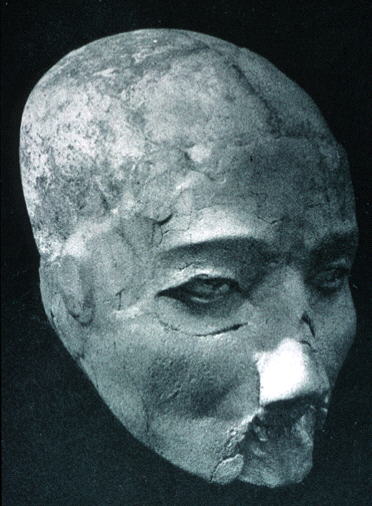
In the case of the skulls of Jericho, the sculpture work is put into effect directly on the human skull, and moreover it aims at the representation of the person dead as it was as alive, using sometimes fretted shells in place of the eyes (in order to represent pupils), the painted hair, and, like has been said, some characterizing detail mainly characterizing, like the moustaches.
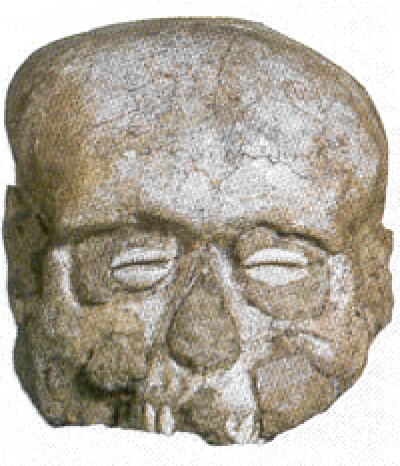
It is that it is matter of funeral mask, or conservation of the skull for apotropaic scope, or of simple cult of the dead men, these skulls undoubtedly are also a splendid work of art, not being still, in that age, some other equally "beautiful" testimony of the human representation.
It is possible to support that these heads in chalk places themselves to the base of the successive ones, greater sculptures of the Middle East.
It could also be said that, with these works of art, begins the tradition of portrait, that never has been interrupted in the time and that lasts still today.
Aegyptians Pharaohs Thutmose I and Thutmose II victoriously carried the northern border until the Euphrates, near the turkish border of today.Thutmose III (1490-1436), then, pushed himself victoriously on the coast where now are Israel, Lebanon, Syria and Jordan.
Even if we do not have sure evidences that were in Egypt rappresentants of the people of Anatolia, Syria and Palestine, such to have carried there also their artistic tradition, that found just one of its more original expressions in the cult of the skulls, is therefore possible that, with the prisoners, came exported in Egypt also an artistic tradition, in particular that one of the sculpture in chalk.
However, the 350 "letters of Al-Amarna", written in cuneiform characters on tablets in clay, regarding the vicissitudes of the defeated people syrian-palestinian at the time of Amenofi III and Amenofi IV/Akhenaton (approximately 1500/1300 B.C.), testify tightened cultural and commercial contacts between Egypt and the people of the East (Cyprus, beyond Lachish, Tell es-Safi, Gezer, Jerusalem, Shechem, Ta' anach, Megiddo, Hazor).
In six of these letters, sended by Biridiya, king of Megiddo, to aegyptian Pharaoh Akhenaton, between other things, he makes reference to the vicissitudes of this key-city, placed in key-position on the Way of the Sea (that tied Egypt with Mesopotamia, Syria and Anatolia), splendid crib of art, like testified from magnificent sculturines in ivory, used like decorations for furnitures, coffers of jewels, cosmetic containers, that reveal aegyptian, hittite and Aegean influences, found in a semibasement of a palace (XIII century B.C.).
Thot-Mosis III (1505-1450), just at Megiddo, beated 330 Syrian princes, incorporating the cananean city in the New Reign; then he submitted southern Syria until Qadesh.
Traces of an amazing and never seen in Egypt sculptural tradition of naturalistic type are found again at the time of Akhenaton, atypical figure of Pharaoh, particularly illuminated on the spiritual plan, remembered also because, with the beautifulst wife Nefertiti, introduced in revolutionary way the cult of an only God, symbolized from the solar disc, divinity in front of which all, in absolutely extraordinary way for the times and the circumstances, came considered equal.
Some scholars are intentionated to see strong ties between this revolutionary ideology and the Ebraism with the cult of Javhè.
Let follow for a little these involved vicissitudes.
Already around the court of the effeminate Thot-Mosis IV (1400-1390), son of an Asian beauty, whose wife was daughter of Artatama I, Ariane king of Mitanni (mother of Amenhotep III, and grandmother of Akhenaton), sure many influences of the Near East were attracted.
Tyie, wife of Amenhotep III, and mother of Akhenaton, according to some sources was Semite, or Hittite or Ariane. Her father Yuia was an Indo-European nobleman, perhaps hurrian, like all the knights of the Aegyptians, educated in Egypt, priest of Amon (in ancient Egypt, God of the meteoric sky, of which the sun constituted the right eye, the moon the left) and of Hermonthis, official of Tuthmosis IV and Amenhotep III, and chancellor of the North.
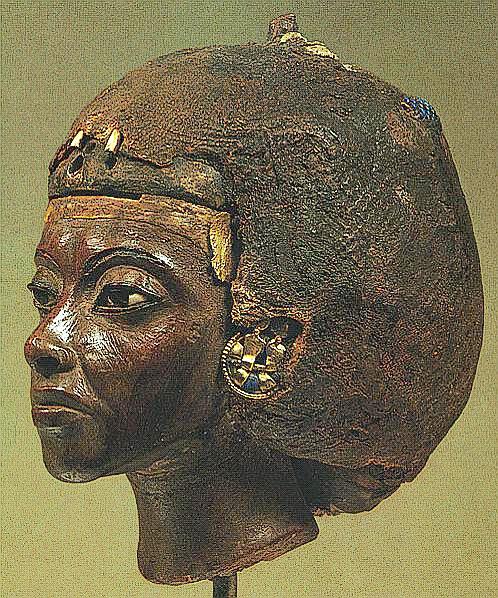
Tyie, refined woman, which in her turn had a deep infuence on the thought and on the art, encouraged the artists to watch the world with their eyes, and to exit from the then rigid ruling manierismus, probably in this resuming a tradition of the Middle East, that in that moment shone at Creta, and of which the head of Jericho is just prototype.
Towards 1539 B.C., Nefertiti and Akhenaton, in his turn succeeded to the father, were moved in the new capital of Egypt, Akhet-Aten, "the horizon of Aton", today Tell-el Amarna, discovered on ending of the ' 700 by the napoleonic scholars, an architectonic exultation enriched from a splendid art.
It was just then that the sculpture, in special way, knew a fantastic blooming (is spoken stylistically about Art of Amarna), thanks also to the master sculptor Thutmose. In his rich laboratory, uncovered eventfully in 1912 by L.Borchardt at Tell el-Amarna, beside unfinished sculptures in stone, they were found a score of prototypes of stamps in chalk that attest the several stages of the working, with the features of personages of the family of the Pharaoh, and to the most famous painted bust of Nefertiti (1379-1362 B.C.), limestone, with a single eye, whose modeled delicacy reminds very closely the finely modeled skull of Jericho.

Beside the idealized heads, many realistic images of men and common women, studied and portrayed in individualized and much faithful way to the signs of the age. Probable indication of a realistic intentional study, since a request of private sculpture is not known that justifies such stylistic choice and such executions.

We remember that in the amarnian sculpture it was often made resorted to the chalk: united to it, in the same work of art, were employed many materials . As an example, the bust of Nefertiti is in limestone, but covered of chalk, and the conical hat is made in chalk, also for a problem of weight and static solidity of the sculpture.
Already previously, they were in use mortuary masks, but in the amarnite period the moulds in chalk came taken directly on the face of living, covered with papyrus or thin canvas, that rendered imperfect the features of the face, that then had to come by hand retouched, with a procedure that remembers the modelling of the features of living on the skulls to Jericho. The armanian art, in fact, stretched not to idealize, but to maintain the real characteristic, as happened for the modelled skulls of Jericho, strongly individualized and expressive.
An other example of this tradition, living also near other cultures in other places of the earth, is inSierra Madre of the Sur, western Mexico, near the Chontal civilization of the pre-Hispanic period, whose figurative sculpture, beginning from 1500 B.C., appears closely connected to the cult of the dead men.
The derivation of such civilization from euroasiatic people gives reason of this tradition, integrally carried in the sculpture, whose origins probably stay they also in this skull-sculpture of Jericho (see head of Holy Jeronimo, Great coast, Mexico).
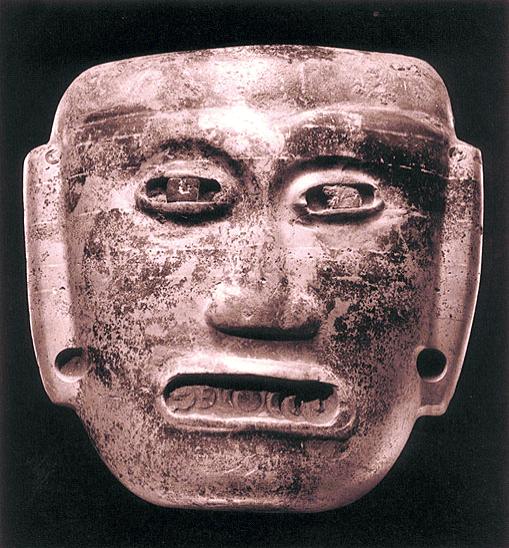
Also in these sculptures, without neck, and often with aspect of mask, the eyes are constituted from shells and the mouths are sometimes of a material different from the rest.
The successive mobile art of Teotihuacan (500-100 B.C.) presumablly is inspired in its turn by this tradition.
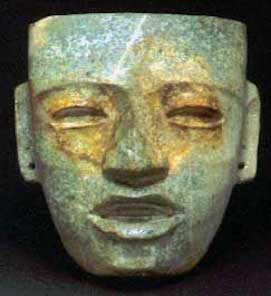
Ethnographic studies referred to Mexico and Oceania signal the presence of ritual masks reproducing the ancestors, based on this belief, according which the power of a man resides just in his head.

Therefore, since the beginning, art and cult of the dead men appear closely interlaced, much to make to think, to an only original root of artistic representation and idea of religious trascendence in the mind of the man.
We know that when, in a net of social relations, language (and art is a shape of language) and practical activity (and art is also practical activity) converge, separated intelligence is shaped, and symbolic activity creates new behavior shapes.
Exhibited art, like sign, catalyzes the attention of the observer and puts in motion abstraction processes that lead the human mind to the processes more elevate of thinking, creating shared and sharable concepts, between which is numbered also that religious one .
Now, if it is true that the attention of the observer is that initially pursued by the executor of the work (the carved image addresses the attention of who watches it), is equally true that the attention deals with given meaning, that must be picked like meaningful, and later interiorized, by who observes it.
Shared indication, therefore, from external, becomes inner.
Such operation of trascendence has also the effect to increase the ability of the man to widely connect immediate ideas and activities to other possible ones, until the most abstract, although shared, those that have to deal with the extreme point of the trascendence, constituted from the sphere of the spirituality and the religion.
It is understood therefore the reason for which the type of artistic representation carried from these skulls-object of cult, being subtended a powerful concept of religious trascendence socially shared and sharable, has been handed on through innumerable generations in every part of the earth, in order to reach nearly unchanged until us, under shape of celebrative sculptural image, in perennial memory of those who are not more.
Copyright©2000-2003 by Paleolithic Art Magazine, all rights reserved.